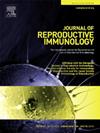新的T细胞受体在精子和睾丸中的表达特征
IF 2.9
3区 医学
Q3 IMMUNOLOGY
引用次数: 0
摘要
除了起源细胞的髓系外,在精子和女性生殖道中也检测到t细胞受体(TCRs)的异位表达,这与主要组织相容性复合体(MHC)分子一起表明它们参与了配偶选择。考虑到MHC/TCR相互作用可以引导精子走向卵子,本研究旨在通过-à-vis同源识别来描述TCR在精子中的存在,并定义其在精子发生过程中的表达。对BALB/c雄性不育小鼠进行的免疫荧光实验表明,尽管是近交系起源,但可以检测到TCRαβ和TCRγδ高表达(HI, >;20 %表达)和低表达(LO, <;5 %表达)的所有组合,其分布率相等,其次是MHC表达的反向模式。TCRαβΗΙ样品不表达MHCI/II,而TCRαβLO/TCRγδHI样品的MHCII表达增加。高表达TCRαβ样品也表达CD3e和CD4,但低于预期水平。所有病例的精液中均检测到可溶性tcr和mhc,其中TCRαβ与MHCI/II高度相关,TCRγδ与MHCI高度相关。除了经典的α、β、γ和δ转录本外,RT-PCR实验还检测到其他尚未鉴定的α和γ基因产物。荧光显微镜下检测到精子尾部TCRαβ和TCRγδ的表达。睾丸的免疫组织学和细胞分离也检测到TCR在精子发生过程中的表达。除了揭示了TCRs在非t细胞中的新结构、功能和调控特征外,研究结果还支持TCRs参与男性生殖,并可作为不明原因不育的诊断标志物。本文章由计算机程序翻译,如有差异,请以英文原文为准。
Novel T cell receptor expression features in sperm and testis
Except from the myeloid in origin cells, ectopic expression of T-cell receptors (TCRs) was also detected in sperm and the female reproductive tract, which in conjunction with major histocompatibility complex (MHC) molecules suggested their involvement in mate choice. Following-up these observations and considering that MHC/TCR interactions could guide spermatozoa towards ovum, the present study aimed to delineate the presence of TCRs in sperm vis-à-vis cognate recognition and define such expression during spermatogenesis. Immunofluorescence experiments using fertile BALB/c males showed that despite the inbred origin of mice, all combinations of high (HI, >20 % expression) and low (LO, <5 % expression) TCRαβ and TCRγδ expression could be detected in equal distribution rates, followed by an inverse pattern of MHC expression. Samples TCRαβΗΙ did not express MHCI/II, but TCRαβLO/TCRγδHI samples showed increased expression of MHCII. High expression TCRαβ samples also expressed CD3e and CD4, but at lower than expected levels. In all cases, soluble TCRs and MHCs were detected by ELISA in the seminal fluid, where TCRαβ highly correlated with MHCI/II and TCRγδ with MHCI. Except from the classical α, β, γ and δ transcripts, RT-PCR experiments detected additional, not-yet identified products for α and γ genes. Fluorescent microscope analysis identified TCRαβ and TCRγδ expression in spermatozoa tail. Immunohistology and cell dissociation of testis also detected TCR expression during spermatogenesis. Apart from un-folding novel structural, functional and regulatory features of TCRs in non-T cells, the results favor the involvement of TCRs in male reproduction and could serve as diagnostic markers in unexplained infertility.
求助全文
通过发布文献求助,成功后即可免费获取论文全文。
去求助
来源期刊
CiteScore
6.30
自引率
5.90%
发文量
162
审稿时长
10.6 weeks
期刊介绍:
Affiliated with the European Society of Reproductive Immunology and with the International Society for Immunology of Reproduction
The aim of the Journal of Reproductive Immunology is to provide the critical forum for the dissemination of results from high quality research in all aspects of experimental, animal and clinical reproductive immunobiology.
This encompasses normal and pathological processes of:
* Male and Female Reproductive Tracts
* Gametogenesis and Embryogenesis
* Implantation and Placental Development
* Gestation and Parturition
* Mammary Gland and Lactation.

 求助内容:
求助内容: 应助结果提醒方式:
应助结果提醒方式:


